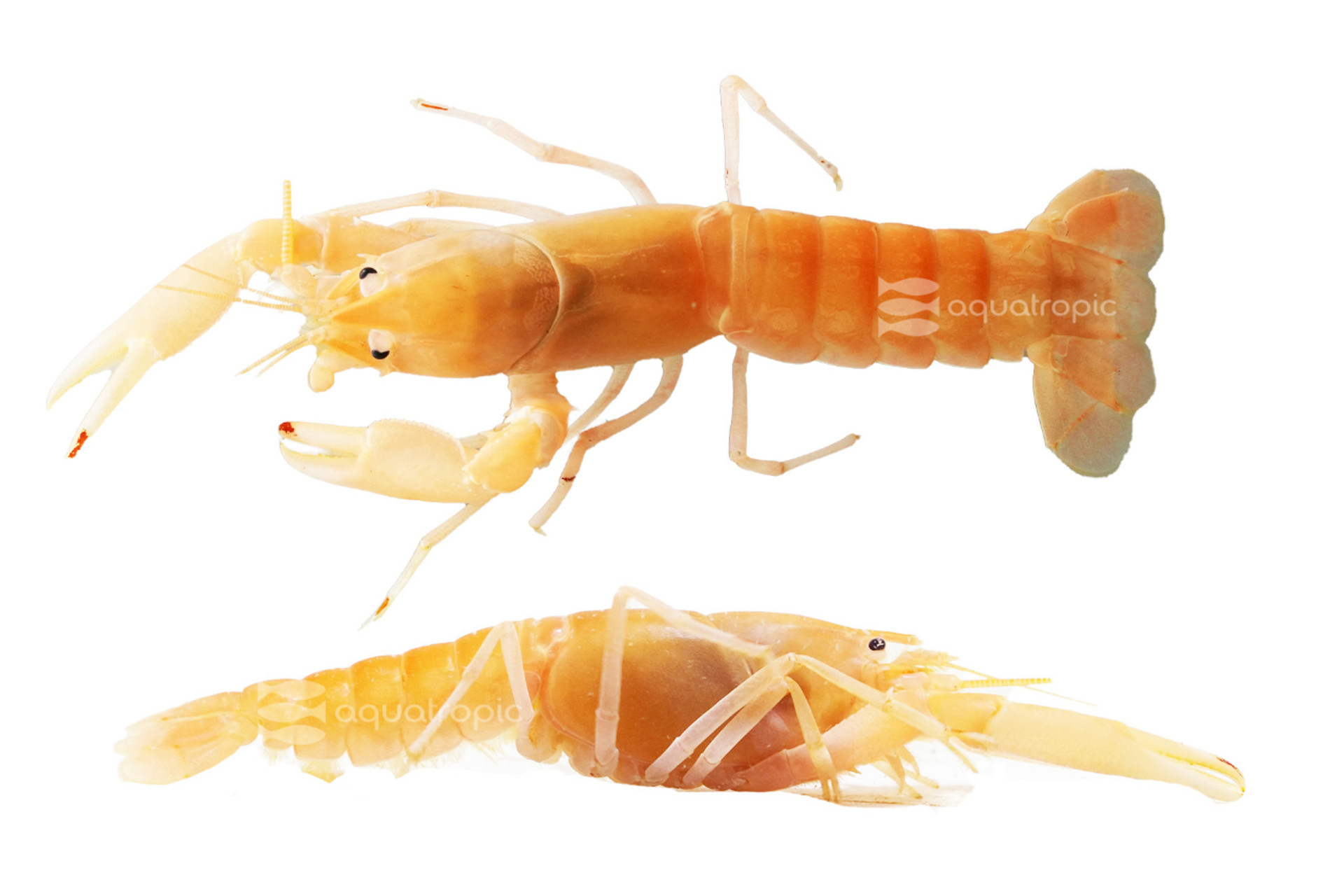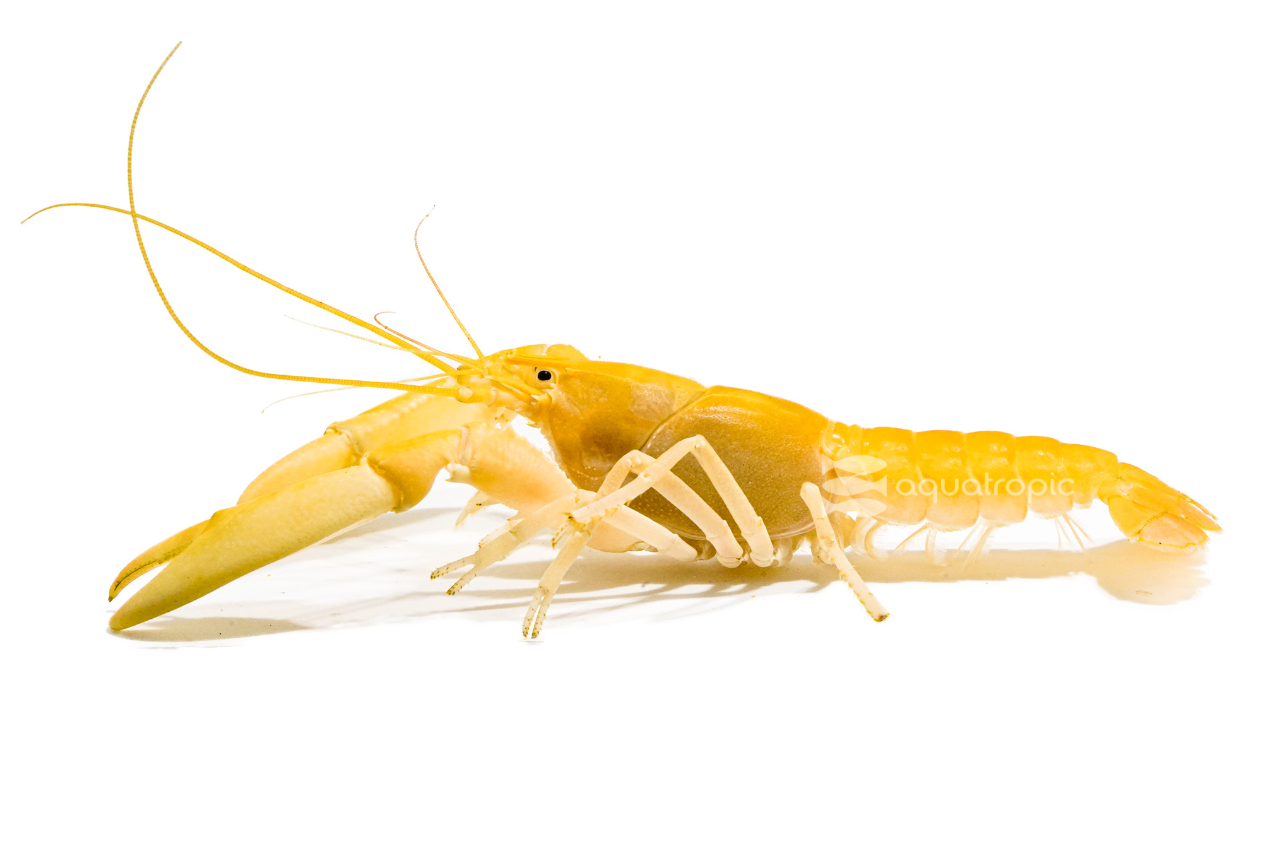The Whole Thuisi

When is a lobster not a lobster? When it's from freshwater! Then it is a crayfish, or crawfish, or crawdad, or mudbug, or whatever else you might call them in your neck of the woods. Regardless of this, people have a tendency to rebrand crayfish as lobsters. Perhaps it is because lobsters seem more exotic or more expensive? Whatever the reason, we are here to talk about a crayfish, Cherax holthuisi, and more specifically, the Apricot Holthuisi. These gorgeous critters are a beautiful, almost pastel apricot color (hence the name). They also frequently get called Orange, and then either Lobster or Crayfish. Rest assured, that if you are in the freshwater portion of your Local Fish Store, and looking at an Apricot Lobster, that the name is only 50% correct.
Cherax holthuisi got its scientific name in 2006, based on specimens circulating in German aquarium stores. It was later realized that they had already been discovered for western science by Dr. Marinus Boseman in 1952 and the specimens he collected had been in the Dutch Natural History Museum for decades already! Their scientific name comes in part to honor Lipke Holthuis, a Dutch carcinoloist who passed away in 2008 after spending his 87 years publishing at least 620 papers on all sorts of crustaceans that the science of carcinology (the study of crustaceans).
The Apricot Holthuisi is a smaller crayfish, never getting much bigger than three and a half inches. They come from a single lake (Aitinjo Lake) and the associated rivers that drain into it in New Guinea. Making them quite rare in the aquarium keeping world. Luckily for us, they are still readily available wild, and also relatively easy to aquaculture, and is widely available as such (and now in even more colors!)
They are peaceful with each other, unless very crowded, and individual species won't need a ton of space. One could be kept in a tank as small as ten gallons, and this is a decent ratio for two as well. We suggest only keeping two of them, regardless of tank size and only one male. We have seen displays where many more are kept, but these were all much bigger, kept a minimum ratio of one crayfish for every 20 gallons, kept only one male, and did not house other crayfish. So, this is possible, but there are some caveats. Displays for Cherax holthuisi should have some substrate for them to burrow in, and the more caves the better. All crayfish like caves that they can barely fit into, and Apricot Holthuisi is no exception. When you look at crayfish, it's hard to imagine them climbing much of anything, but they are adept climbers of just about everything, and will escape your aquarium in the most unexpected ways. Always securely cover crayfish tanks.

Holthuisi Crayfish aren't super sensitive to water quality parameters, but they do like high levels of oxygen saturation, which is always easier in cleaner, colder water. We suggest either filtration that offers a lot of surface agitation, or to add some forced oxygenation to their displays. Their normal range in home waters is a neutral pH (6.5-8ish) and between 70 and 75 degrees. We've found they are fine a little warmer with adequate oxygenation, and a little colder, but they will grow more slowly. These crayfish are fairly tolerant of nitrates, and can be kept with sponge filters, though they will pick at the filters to glean the food off them. We suggest a lot of extra oxygenations if you opt for sponge filters.
Feeding crayfish is always interesting, as they love meaty food, but require a good amount of vegetation in their diet. They are also plodding eaters, especially when grazing, so food needs to be available for a while. Your Holthuisis will have a preference for darkness, and so it makes sense to offer them food at night. Whatever is left over in the morning can get removed. Adult crayfish only need two or three meals a week, but little ones (think less than two inches or so) should probably be fed every day, or every other day. They will take quality processed food like Nutramar's Algae and Color Boost shots, which offer them a good balance of protein and greenery. They will also like clean leaf litter (which can be left in the aquarium for longer, up to a few days) and blanched vegetables like kale and spinach. Fruit can be sparingly fed to crayfish, but it is hard to get most of it to sink! You can also feed your Apricot Holthuisi meaty foods like live or frozen small earthworms, tubifex, or bloodworms. They need a good amount of protein, and if they don't get it, they will be more likely to cannibalize each other, or try to take out other tank mates (if sharing a tank). Some aquarists swear by giving them some eggshells or live snails on a weekly basis to help boost calcium levels in their diet.
These are neat enough crayfish to keep on their own, and a pair of them would offer you the opportunity to breed them in the home aquarium. They can be kept with fish, just don't keep them with very aggressive fish that will push them into hiding. After all, you do want to see your gorgeous apricot colored crayfish! The other thing to consider is that all crayfish are opportunistic omnivores. If they can catch it, they will eat it. They will hunt down snails and have them for snacks and if they can find or catch fish, the same will be true. You want fish that are peaceful, but quick. You should not keep them with other crayfish species. Cherax holthuisi is a digger, and loves eating plants, and so they should not be kept in any kind of planted environment. They will do well with surface plants, as they seem to like the shade provided.
If you're interested in breeding these, just keep a pair together, and when the female is mature and ready, she'll allow herself to be flipped over (even if she is much larger than the male) and he will clamp her claws, and deposit spermatophores (a little case full of spermatozoa (basically sperm)) into receptacles on the female's tail. She'll then fold her tail over and use the spermatophores to fertilize her eggs. It takes around a month for the eggs to hatch, and the babies will be perfect miniature crayfish. They will eat powdered food, leaf litter, and detritus. Make sure the adults are well fed during this period, or they will cannibalize the youth. As soon as the babies leave the mother's tail, you can also remove them to their own aquarium for grow out!
If you've ever wanted a crayfish (go ahead, you can call it a lobster if you want) for your freshwater tank the Apricot Holthuisi is one of the best choices you can make. They are peaceful as far as crayfish go, absolutely gorgeous, pretty easy to keep and may even reproduce for you! Head to your local fish store and ask them to get you a pair of Apricot Holthuisi from Aquatropic today!